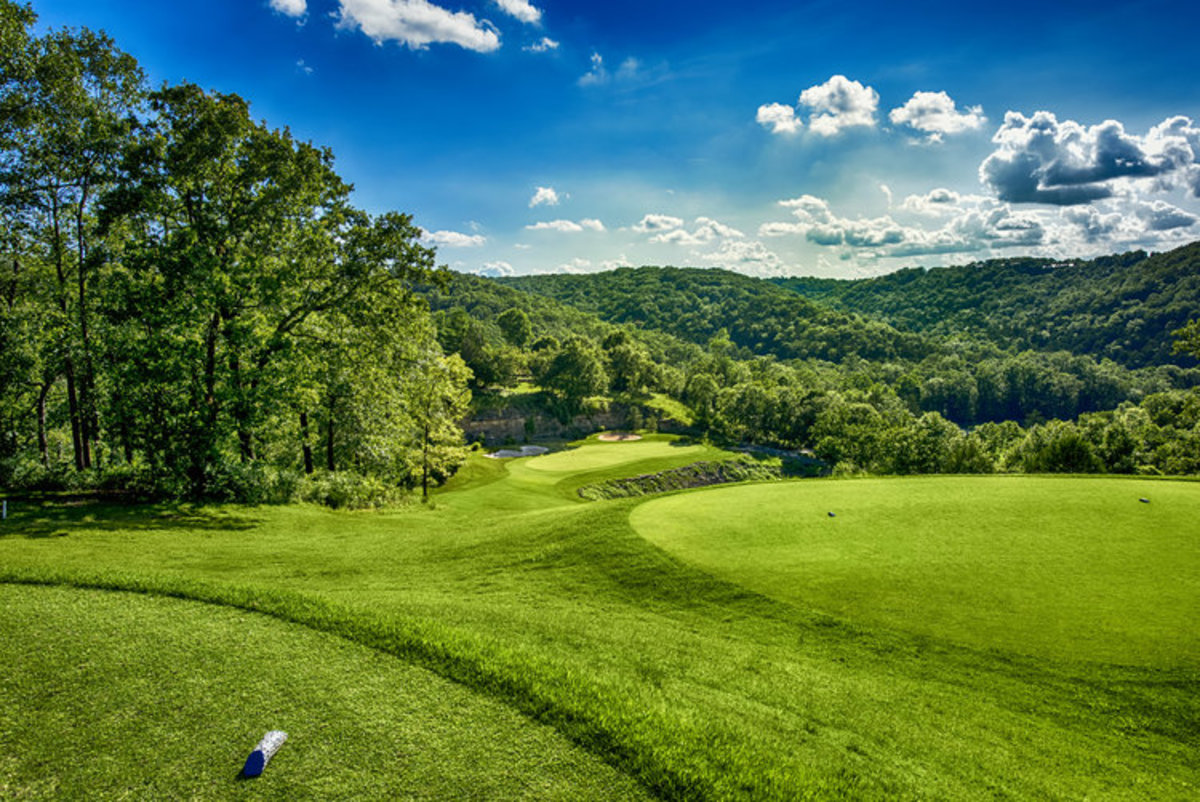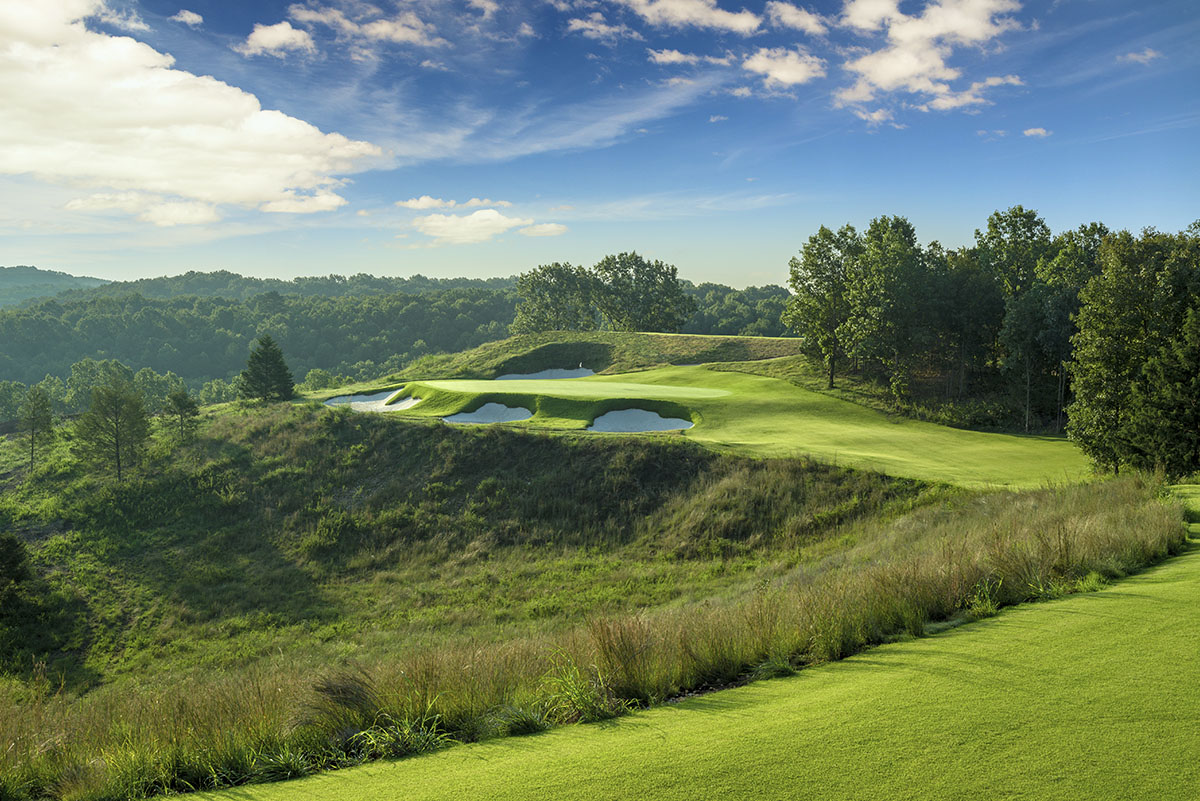Branson Offers Courses Both Famous and Undeservingly Obscure, But All Are Dramatic

On some courses, a proclaimed signature hole is well-deserving of the fanfare it receives. The 17th at TPC Sawgrass immediately comes to mind, as does the 16th hole at Cypress Point or the 4th hole at Old Head Golf Links. At those courses, the most memorable shot that you’ll hit during your round — good or bad — is likely to take place on those holes.
Such is not the case at Ledgestone Country Club about seven miles northwest of downtown Branson, Missouri.
For years, many who have worked at the 29-year-old golf course have asserted that the layout’s signature hole is No. 15, a long, downhill par 3 aptly named “Quarry” for a deep hazard that fronts the green — its steep rock-and-boulder-strewn banks falling precipitously away to a pond below. The hole plays about 200 yards at its full length and drops so much in elevation that the aforementioned hazard can’t be seen from the back tees.
Regardless of the teeing area from which golfers play, the requisite opening shot at Ledgestone’s 15th hole is defined by a number of variables: the usual suspects —elevation, wind and hole location — as well as a player’s confidence. Simply put, only a well-struck tee shot will have a chance to clear the hazard, so golfers will do well to make sure the club in their hands is one they can swing with conviction.
Without question, the 15th at Ledgestone is a dramatic hole, it’s just not the one that stands out over the rest. “Is it the one people remember the most?” asks Phillip Drips, Ledgestone’s head pro. “Maybe, because they’ve never hit a tee shot like that before. But I don’t think that’s the signature hole.”
Arguments could be made that the following hole deserves Ledgestone’s signature stamp. Branded “The Big Chill,” the 16th is a daunting downhill par 4 that doglegs sharply to the right and plays 416 yards from the back tees. The tee shot (hit from elevated boxes) requires both length and precision, as there’s not much room left of the fairway and a densely wooded area runs down the entire right side. It’s a shot that will often have players holding their breath while the ball is in the air. However, once golfers reach the landing area, the dramatic nature of the hole fully reveals itself.

Good drives are likely to leave only a short iron or wedge into the green, but that green is guarded by a stream-fed pond that protects much of the front and all of the right side of the putting surface. Making matters worse, a tall deciduous tree towers over the left edge of the fairway only 50 yards or so from the green, which tightens the shooting alley even more. Golfers who hit long drives toward the back edge of the fairway (when viewed from the tee) will likely need to hit approach shots that draw around the branches of that tree. However, doing so means they’ll need to start those shots out over the water. The yardage book offers sage advice: “Don’t feed golf balls to the fish.” Such advice is easily shared, though harder to follow.
“You can make double [bogey] really easily on that hole,” says Drips, who once arrived at the 16th tee 4-under through his round and promptly carded a quintuple bogey. That’s right, a nine. “It’s the number one handicap hole on the course for a reason,” he adds.
In truth, there may not be a singular hole at Ledgestone that distinguishes itself from the pack, and therein lies one of the golf course’s most admirable strengths. The closing stretch is teeming with features that could support an argument that any of the final five holes could be Ledgestone’s signature. “It builds and builds and builds,” Drips says of the compelling nature of the course’s back nine.

Five miles to the east, Branson Hills Golf Club shines equally bright for a layout that is carved through the Ozarks Mountains. Like Ledgestone, Branson Hills delivers an eclectic mix of holes — some defined by dramatic changes of elevations, others by natural rock outcroppings, creeks and waterfalls. There, the bentgrass greens roll quick and true, and when the wind blows, the 7,324-yard course becomes a monster almost impossible to slay.
With its deep history of live stage shows and almost 40 theaters, the city of Branson has not only earned the nickname “the live entertainment capital of the world,” but it also attracts millions of visitors each year (almost 10 million in 2021). For much of the last decade, however, more travelers are making pilgrimages to the greater Branson area with their golf clubs in tow.
The region’s golf tourism boom coincided with Johnny Morris’ decision to acquire Branson Creek Golf Club and subsequently commissioning Tom Fazio to undertake a dramatic redesign of the layout. Now known as Buffalo Ridge, the 7,036-yard course serves as one of three pillars of championship golf at Big Cedar Lodge. In the years that followed, Morris partnered with other prominent course designers — Gary Player, Coore & Crenshaw and, most recently, Tiger Woods — to create additional, compelling golf layouts at the resort.
Each one offers a distinctive playing experience, breathtaking views, and dramatic natural landforms; and all work in tandem to further Morris’ mission statement: encouraging people to explore and enjoy the natural beauty of the Ozarks as he did growing up. “I think of golf like fishing in a way,” he says. “It’s an excuse to get outside and an opportunity to spend time with people you care about.”

Big Cedar’s lineup of courses serve as Branson’s high watermark for exceptional golf, and while they boast outstanding architecture and superb routing, those attributes only tell a portion of the story. After all, there are stretches of holes at other area courses — the aforementioned closing stretch of holes at Ledgestone, for example — that are as memorable as any sequence of holes found on any of Big Cedar’s championship courses. It’s their conditioning, especially early in the golfing season, where Big Cedar’s bucket-list courses separate from the pack.
It was almost two years ago when Payne’s Valley was introduced to the world on the Golf Channel via a Ryder Cup-inspired exhibition that pitted Woods (the course’s architect) and Justin Thomas against Rory McIlroy and Justin Rose. In that time, the 7,370-yard course — Woods' first public course in the United States — has accrued the lion’s share of Big Cedar’s golf coverage. Such is an understandable reality, given the course’s broad, rolling fairways; its challenging, severely contoured greens; and the panoramic vistas that can be enjoyed from many vantage points across those 18 holes.
Ozarks National — a 7,036-yard layout conceived by Bill Coore and Ben Crenshaw — sparkles brightest and serves as Big Cedar’s crown jewel of golf. Routed along a series of ridges, Ozarks National will appeal to those with a penchant for Golden Age golf architecture ideals, as Coore & Crenshaw adhered to many of the same philosophies and strategies that guided C.B. Macdonald through his creation of National Golf Links of America in 1908.

“It creates a sensation and an experience that just very straightforward, stereotypical golf cannot provide,” Coore says of the course, which sports undulating fairways and punchbowl greens, and occasionally requires players to hit blind shots over gradually sloping hillsides. “Maybe the golf course looks intimidating, but after you play it you’ll find that it looks much harder than it really is.”
Those familiar with Coore & Crenshaw’s work will immediately see the duo’s fingerprints across the land, as the course fits naturally into the terrain—so much so, in fact, that its appearance belies the course’s youth. “We try to find property that looks and feels like golf in its natural state,” Coore explains. “Properties that don’t require extreme alterations. Then we let the natural characteristics of those sites be the guide to create the character and strategy of those courses.”
Built upon firm terrain with plenty of sloping contours and mounding, Ozarks National is a course that, as Coore acknowledges, rewards “an adventurous or inquisitive spirit.” It also excels for its variety. “It’s a diverse collection of holes,” adds Crenshaw. “It’s got a little bit of everything.”
While such a statement aptly describes a round at Ozarks National, it speaks in broader terms as well — not just about the eclectic mix of courses at Big Cedar Lodge but to the championship-quality golf that can be found throughout much of Branson.
